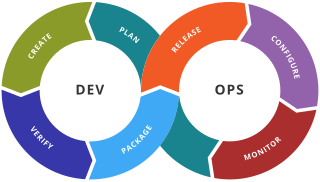Related Research Articles
In software testing, test automation is the use of software separate from the software being tested to control the execution of tests and the comparison of actual outcomes with predicted outcomes. Test automation can automate some repetitive but necessary tasks in a formalized testing process already in place, or perform additional testing that would be difficult to do manually. Test automation is critical for continuous delivery and continuous testing.
Application lifecycle management (ALM) is the product lifecycle management of computer programs. It encompasses requirements management, software architecture, computer programming, software testing, software maintenance, change management, continuous integration, project management, and release management.
AnthillPro is a software tool originally developed and released as one of the first continuous integration servers. AnthillPro automates the process of building code into software projects and testing it to verify that project quality has been maintained. Software developers are able to identify bugs and errors earlier by using AnthillPro to track, collate, and test changes in real time to a collectively maintained body of computer code.

Parasoft is an independent software vendor specializing in automated software testing and application security with headquarters in Monrovia, California. It was founded in 1987 by four graduates of the California Institute of Technology who planned to commercialize the parallel computing software tools they had been working on for the Caltech Cosmic Cube, which was the first working hypercube computer built.
API testing is a type of software testing that involves testing application programming interfaces (APIs) directly and as part of integration testing to determine if they meet expectations for functionality, reliability, performance, and security. Since APIs lack a GUI, API testing is performed at the message layer. API testing is now considered critical for automating testing because APIs now serve as the primary interface to application logic and because GUI tests are difficult to maintain with the short release cycles and frequent changes commonly used with Agile software development and DevOps.
Release management is the process of managing, planning, scheduling and controlling a software build through different stages and environments; it includes testing and deploying software releases.
DevOps is a methodology in the software development and IT industry. Used as a set of practices and tools, DevOps integrates and automates the work of software development (Dev) and IT operations (Ops) as a means for improving and shortening the systems development life cycle. DevOps is complementary to agile software development; several DevOps aspects came from the agile way of working.
Continuous delivery (CD) is a software engineering approach in which teams produce software in short cycles, ensuring that the software can be reliably released at any time and, following a pipeline through a "production-like environment", without doing so manually. It aims at building, testing, and releasing software with greater speed and frequency. The approach helps reduce the cost, time, and risk of delivering changes by allowing for more incremental updates to applications in production. A straightforward and repeatable deployment process is important for continuous delivery.
Application-release automation (ARA) refers to the process of packaging and deploying an application or update of an application from development, across various environments, and ultimately to production. ARA solutions must combine the capabilities of deployment automation, environment management and modeling, and release coordination.
In software engineering, service virtualization or service virtualisation is a method to emulate the behavior of specific components in heterogeneous component-based applications such as API-driven applications, cloud-based applications and service-oriented architectures. It is used to provide software development and QA/testing teams access to dependent system components that are needed to exercise an application under test (AUT), but are unavailable or difficult-to-access for development and testing purposes. With the behavior of the dependent components "virtualized", testing and development can proceed without accessing the actual live components. Service virtualization is recognized by vendors, industry analysts, and industry publications as being different than mocking. See here for a Comparison of API simulation tools.
XebiaLabs is an independent software company specializing in DevOps and continuous delivery for large enterprise organizations. The offers a DevOps Platform, for application-release automation (ARO). These components include release orchestration, deployment automation, and DevOps intelligence.
Infrastructure as code (IaC) is the process of managing and provisioning computer data centers through machine-readable definition files, rather than physical hardware configuration or interactive configuration tools. The IT infrastructure managed by this process comprises both physical equipment, such as bare-metal servers, as well as virtual machines, and associated configuration resources. The definitions may be in a version control system. The code in the definition files may use either scripts or declarative definitions, rather than maintaining the code through manual processes, but IaC more often employs declarative approaches.

A DevOps toolchain is a set or combination of tools that aid in the delivery, development, and management of software applications throughout the systems development life cycle, as coordinated by an organisation that uses DevOps practices.

Tricentis is a software testing company founded in 2007 and headquartered in Austin, Texas. It provides software testing automation and software quality assurance products for enterprise software.
Continuous configuration automation (CCA) is the methodology or process of automating the deployment and configuration of settings and software for both physical and virtual data center equipment.
DataOps is a set of practices, processes and technologies that combines an integrated and process-oriented perspective on data with automation and methods from agile software engineering to improve quality, speed, and collaboration and promote a culture of continuous improvement in the area of data analytics. While DataOps began as a set of best practices, it has now matured to become a new and independent approach to data analytics. DataOps applies to the entire data lifecycle from data preparation to reporting, and recognizes the interconnected nature of the data analytics team and information technology operations.
This article discusses a set of tactics useful in software testing. It is intended as a comprehensive list of tactical approaches to Software Quality Assurance (more widely colloquially known as Quality Assurance and general application of the test method.
Tricentis Tosca is a software testing tool that is used to automate end-to-end testing for software applications. It is developed by Tricentis.

Katalon Platform is an automation testing software tool developed by Katalon, Inc. The software is built on top of the open-source automation frameworks Selenium, Appium with a specialized IDE interface for web, API, mobile and desktop application testing. Its initial release for internal use was in January 2015. Its first public release was in September 2016. In 2018, the software acquired 9% of market penetration for UI test automation, according to The State of Testing 2018 Report by SmartBear.
TestOps refers to the discipline of managing the operational aspects of testing within the software delivery lifecycle.
References
- 1 2 3 4 5 6 7 8 9 Part of the Pipeline: Why Continuous Testing Is Essential, by Adam Auerbach, TechWell Insights August 2015
- 1 2 3 4 5 6 The Relationship between Risk and Continuous Testing: An Interview with Wayne Ariola, by Cameron Philipp-Edmonds, Stickyminds December 2015
- ↑ Saff, D.; Ernst, M.D. (20 Nov 2003). Reducing wasted development time via continuous testing. 14th International Symposium on Software Reliability Engineering, 2003. Denver, CO, USA: IEEE. pp. 281–292. ISBN 0-7695-2007-3. ISSRE 2003. Archived from the original on 1 August 2016. doi : 10.1109/ISSRE.2003.1251050
- 1 2 3 4 5 6 7 8 9 10 11 DevOps: Are You Pushing Bugs to Clients Faster, by Wayne Ariola and Cynthia Dunlop, PNSQC October 2015
- 1 2 3 4 DevOps and QA: What’s the real cost of quality?, by Ericka Chickowski, DevOps.com June 2015
- 1 2 3 The Importance of Shifting Right in DevOps, by Bob Aiello, CM Crossroads December 2014
- 1 2 Kinks persist in Continuous Workflows, by Lisa Morgan, SD Times September 2014
- ↑ Continuous Testing: Think Different, by Ian Davis, Visual Studio Magazine September 2011
- 1 2 3 4 5 6 Testing in a Continuous Delivery World, by Rob Marvin, SD Times June 2014
- 1 2 3 4 5 6 Shift Left and Put Quality First, by Adam Auerbach, TechWell Insights October 2014
- 1 2 3 The Forrester Wave™ Evaluation Of Functional Test Automation (FTA) Is Out And It's All About Going Beyond GUI Testing, by Diego Lo Giudice, Forrester Research April 23, 2015
- 1 2 Continuous Development Brings Changes for Software Testers, by Amy Reichert, SearchSoftwareQuality September 2014
- 1 2 3 Zeichick’s Take: Forget 'Continuous Integration'—the Buzzword is now 'Continuous Testing', by Alan Zeichick, SD Times February 2014
- ↑ Buy the Wrong Software? A Fix Can Cost $700,000 A Conversation with voke’s Theresa Lanowitz, by Dom Nicastro , CMS Wire October 2014
- ↑ Jones, Capers; Bonsignour, Olivier (2011). The Economics of Software Quality. Addison-Wesley Professional. ISBN 978-0132582209.
- ↑ Kolawa, Adam; Huizinga, Dorota (2007). Automated Defect Prevention: Best Practices in Software Management. Wiley-IEEE Computer Society Press. p. 73. ISBN 978-0-470-04212-0.
- 1 2 Theresa Lanowitz Talks Extreme Test Automation at STAREAST 2014, by Beth Romanik, TechWell Insights May 2014
- ↑ Guest View: What’s keeping you from Continuous?, by Noel Wurst, SD Times November 2015
- ↑ Manage the Business Risks of Application Development with Continuous Testing, by Wayne Ariola, CM Crossroads September 2014
- 1 2 The Power of Continuous Performance Testing, by Don Prather, Stickyminds August 2015
- ↑ Practices for DevOps and Continuous Delivery, by Ben Linders, InfoQ July 2015
- ↑ Produce Better Software by Using a Layered Testing Strategy [ dead link ], by Sean Kenefick, Gartner January 7, 2014
- ↑ Cohn, Mike (2009). Succeeding with Agile: Software Development Using Scrum . Addison-Wesley Professional. p. 312. ISBN 978-0321579362.
- 1 2 Experiences from Continuous Testing at Siemens Healthcare, by Ben Linders, InfoQ February 2015
- ↑ DevOps- Not a Market, but a Tool-Centric Philosophy That Supports a Continuous Delivery Value Chain, by Laurie F. Wurster, Ronni J. Colville, Jim Duggan, Gartner February, 2015
- ↑ Keep your Software Healthy During Agile Development, by Adrian Bridgwater, ComputerWeekly November 2013
- ↑ Extreme automation, meet the pre-production life cycle, by Alexandra Weber Morales, SD Times January 2014
- ↑ Continuous Integration (original version), by Martin Fowler, DevOps.com September 2000
- ↑ Magic Quadrant for Software Test Automation, Gartner, November 25, 2019
- 1 2 "The Forrester Wave: Continuous Functional Test Automation Suites, Q2 2020". Forrester. 2020-06-18. Retrieved 2020-10-16.